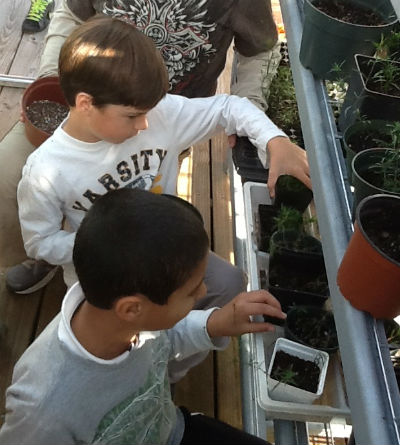 |
 The little greenhouse provides a classroom to teach children at White Oak Elementary School about plants, soil and solar power. Third-grade teacher Dana Edgren makes sure her kids take advantage of it. Photos: Sam Bland |
CAPE CARTERET— White Oak Elementary School has something most grade schools along the coast don’t. It’s a little greenhouse that sits at the end of a concrete walkway at the back of the school’s campus.
But If Sarah Phillips had her way more elementary school would have their own greenhouses.
Supporter Spotlight
Phillips is one of the educators at the N.C. Coastal Federation, and she has worked with teachers at White Oak Elementary in Carteret County since 2007. Their first project was a rain garden near the school’s front entrance that was created to help absorb stormwater from the parking lot and the front of the building. The garden was initially planted by fifth graders, and fifth-grade classes were from then on responsible for maintaining the garden, which meant periodic re-plantings.
Cost, though, became an issue, as did two droughts. Phillips and Dana Edgren, who was then the fifth-grade teacher in charge of the project, needed a cheaper way to maintain the garden that was not so prone to the vagaries of the weather.
“We like to plant new plants each spring but funding was a problem, so I mentioned to Dana that we could get a grant from Walmart for the greenhouse and she was very interested,” Phillips explained.
By then, Edgren had moved to the third grade. That was an even better grade, she decided, to get students interested in learning about plants and the coastal environment. “They are beginning to integrate the lessons into their everyday thoughts, not just learning it and forgetting it,” Phillips added.
“The third grade got a new curriculum and we were studying everything to do with the greenhouse in science, so it went together perfectly,” Edgren said. “They are learning about the soil, composting, rain water collection and solar energy all through this project.”
Supporter Spotlight
Walmart provided the initial grant money. But many other people, groups and businesses were involved. Lowe’s Home Improvement Center, which has a store near the school, donated wood. Newton Construction built the railing, and the Coast Guard donated the solar panels. Edgren’s husband and son donated an enormous amount of time along with some of the other parents, and the federation provided two rain barrels.
“We like to avoid having to spend any of the school’s money for this, so we decided if they had the rain barrels they would have free water and could incorporate that into their lessons,” Phillips added. “The composter and solar panels were all Dana’s idea. It’s been cool for me because sometimes I run out of new ideas, so when a teacher comes up with all of this I see it can be done and it helps me write grants for other schools. It’s important when you do projects to have an interested teacher. She is super excited, and her parents were farmers, so she grew up around plants and is really interested in having the kids learn this way.”
 Students pot plants in the greenhouse at White Oak Elementary School. Photo: Dana Edgren |
The fact that the science lesson on plants, solar energy and soil went from the fifth graders to third graders is a plus as far as Phillips and Edgren are concerned because third graders are old enough to learn the ideas and young enough to still be excited about what they are learning.
“I think it fits better along with the third-grade curriculum because a lot of times kids that age don’t even know where food comes from. They just think it comes from a store,” Phillips said. “It’s a good age; they are really excited about learning.
It’s not only Edgren’s class that is participating, but all the third graders are involved in working in and around the greenhouse. A Garden Club that includes all grades now works on the rain garden.
“I was spending a lot of time in the garden last year, but now I’m seeing more involvement. It’s something I want the kids and parents to do together,” Edgren said.
There are 400 perennials in the greenhouse—all North Carolina native plants, another lesson for the students in the benefits of planting and using natives. Eydan Giesbrecht and Elliot Simonette, both students of Edgren’s, say they have enjoyed learning about the plants and hope to have gardens of their own at home now that they see how it can be done.
“We’ve been coming here a couple of times,” Simonette said. “She has about two or three of us come out here at a time. We got to fill pots with dirt and plant the plants.”
Giesbrecht explained how the composter works. “We’ve gotten a bucket at lunch, we put fruits and vegetables in there and turn it and it turns into dirt,” she said.
Not only have all the White Oak students gotten involved, along with Lowes and Walmart, the Croatan High School agriculture students spent an afternoon helping to “spruce up” the greenhouse.
According to Phillips, Edgren is not opposed to asking for and getting help with the greenhouse project or any project for that matter. In fact, she’s planned a couple of ways the community and parents can get involved with the school project. She is planning a parents and students campus clean-up on March 4 and is encouraging people access a registry at Lowe’s where parents or members of the community can buy items that have been designated as being needed for the school. On March 26, the school will have a Beautification Day where students, parents or anyone interested in helping can come and help beautify the campus.
For more information visit the White Oak Elementary Web site.








